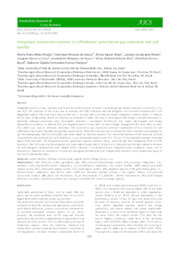Integrated production systems in a Plinthosol: greenhouse gas emissions and soil quality.
Integrated production systems in a Plinthosol: greenhouse gas emissions and soil quality.
Author(s): ARAÚJO, M. D.; SOUZA, H. A. de; SIGNOR, D.; MUNIZ, L. C.; COSTA, J. B.; SOUZA, I. M. de; REIS, V. R. R.; BRASIL, E. P.; POMPEU, R. C. F. F.
Summary: Integrated systems (crops, livestock, and forest) are tools to avoid increases in greenhouse gas (GHG) emissions, such as CO2, CH4, and N2O. The objective of this study was to evaluate the GHG emissions and soil biological and chemical characteristics in an integrated system. The experiment was carried out in an area with crop-livestock-forest integration systems (CLFI), in Pindaré-Mirim, state of Maranhão, Brazil.
Publication year: 2022
Types of publication: Journal article
Unit: Embrapa Mid-North
Keywords: Colheita, Dióxido de Carbono, Floresta, Forragem, Matéria Orgânica, Metano, Óxido nitroso
Observation
Some of Embrapa's publications are published as ePub files. To read them, use or download one of the following free software options to your computer or mobile device. Android: Google Play Books; IOS: iBooks; Windows and Linux: Calibre.
Access other publications
Access the Agricultural Research Database (BDPA) to consult Embrapa's full library collection and records.
Visit Embrapa Bookstore to purchase books and other publications sold by Embrapa.

